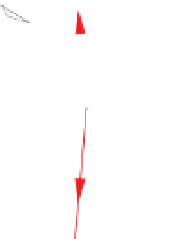Geoscience Reference
In-Depth Information
pseudosections which may be displayed as images or
contours. The true form of the subsurface electrical struc-
ture is usually not easily recognisable in the various dis-
plays. As a consequence, modelling, and in particular
inverse modelling (see
Section 2.11.2.1
), is an integral part
of resistivity/IP interpretation.
Since depth control of the electrical measurements is of
profound importance in their interpretation, we
rst
describe the interpretation of electrical soundings before
describing the analysis of profile and pseudosection data,
the latter having elements of both profiling and soundings.
Finally we describe analysis of map data. Our description
focuses on resistivity data but the same principles are
applicable to IP data. There are a number of pitfalls com-
monly encountered in the interpretation of all types of
electrical data which are discussed in
Section 5.6.7
.
Increasingly resistivity/IP data are being acquired using
a large number of electrodes deployed in a grid to map a
volume of the subsurface. For example, White et al.(
2001
)
describe a survey over a sulphide-rich copper
Unfocused
Focused
Equipotential
surface
Logging tool
Current flow
line
Figure 5.42
Schematic illustration of the
'
focused
'
potential
eld
and current
flow lines of a focused logging array compared with that
of an unfocused array.
surface, the other within the drillhole (
Fig. 5.41c
)
. The
overall resistance of the circuit, comprising the electrical
equipment, wires and the current paths from drillhole wall
to surface, is measured. Since this is to a large extent a
function of the conditions in the drillhole, the data can only
be interpreted qualitatively. A more sophisticated form of
electrical
gold por-
phyry body, which allowed a detailed 3D model of the
deposit to be created.
-
the
current
flow into a thin disc centred on the drillhole
(
Fig. 5.42
). This increases the along-hole resolution of the
data, but requires more sophisticated logging equipment.
There are numerous logging tools of this type, with varying
resolutions and depths of penetration, developed by the
petroleum industry for well-logging in sedimentary envir-
onments. Electrical logging of coal seams is a major appli-
cation in the mining industry.
logging uses potential electrodes to
'
focus
'
5.6.6.1
Vertical electrical soundings
Vertical electrical soundings are surveys that speci
cally
seek to de
ne the vertical variation in electrical properties.
As noted in
Section 5.6.4.1
,
soundings can be made with
any array by focusing the measurement to deeper regions.
The measured parameters are plotted against some func-
tion of the electrode separation, i.e. the pseudo-depth (Z)
in
Fig. 5.40
.
The Wenner and Schlumberger arrays are commonly
used for soundings (see
Section 5.6.5
). In the Wenner array
expanded at logarithmically varying intervals equally about
the midpoint. For the Schlumberger array, only the current
dipole is expanded, in the same way (
Fig. 5.40e
)
, with the
potential electrodes located at the centre of the array. The
current dipole length ranges typically from a few metres to
a few kilometres, if information about the deep subsurface
is required.
5.6.6
Display, interpretation and examples of
resistivity/IP data
When interpreting electrical data it is essential to under-
stand that individual resistivity/IP measurements represent
an average of a large volume of material and that assign-
ment of a measurement to a point in the subsurface is a
matter of convenience rather than physical reality. Only for
the case of an electrically homogeneous subsurface, i.e. a
half-space, is the measurement a true representation of the
actual subsurface properties. For all other situations the
measurement represents a gross simpli
cation of the real
situation.
One-dimensional data are presented as pro
les.
Two-dimensional data comprise pseudo-depth maps or
Sounding curves
Figure 5.43
shows computed Schlumberger array sound-
ings for idealised two-layer ground models to illustrate
how changes in the thickness and resistivity of the upper
layer affect the sounding curve. The logarithm of resistivity
is plotted against the logarithm of pseudo-depth, in this



























Search WWH ::

Custom Search